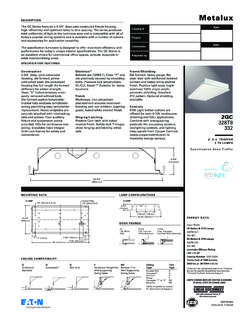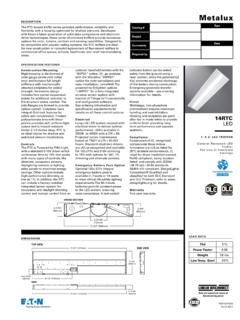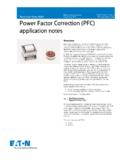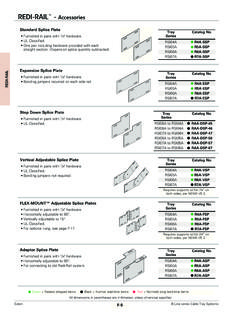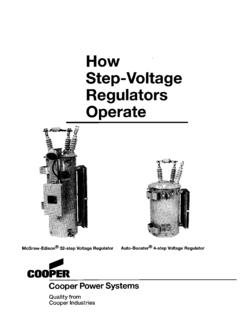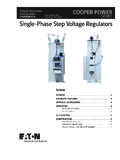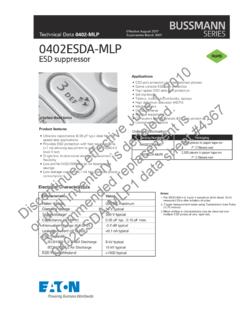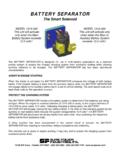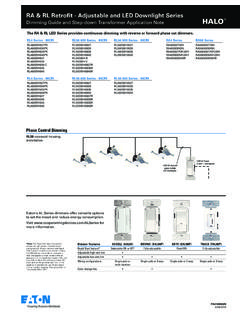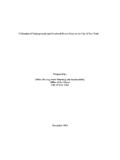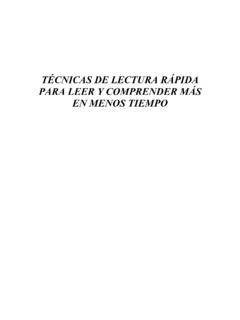Transcription of Fuse Sizing - Cooper Industries
1 fuse SizingFuse Sizing GuideThis guide is a general recommendation and does notinclude the many variables that can exist for specific situations such as special local codes, unusual temperatureor other operating conditions, NEC demand factors, conductor derating, UL Current Limiting fuse Classes & EDI-SON Fusegear Symbols:*Time-Delay TypeClass L LCL 600 VAC or less: 601-6000 AClass RK1 LENRK 250 VAC or less: 6/10-600A LESRK 600 VAC or less: 1/2-600 AClass RK5 ECNR 250 VAC or less: 1/10-600A ECSR 600 VAC or less: 1/10-600 AClass J JDL 600 VAC or less: 1-600 AClass CC HCTR 600 VAC or less: 1/4-10 AFast-Acting Type (Non/time-delay)Class T TJN 300 VAC or less: 1-800A TJS 600 VAC or less: 1-800 AClass L LCU 600 VAC or less: 601-6000 AClass RK1 NCLR 250 VAC or less: 1-600A SCLR 600 VAC or less: 1-600 AClass J JFL 600 VAC or less: 1-600 AClass CC HCLR 600 VAC or less: 1/10-30A*The fuse classes shown are UL Listed as current limiting with 200,000 RMSsymmetrical amperes interrupting rating.
2 Classes J and L are not inter-changeable with fuses having lower Class R fuses require Class R rejec-tion fuse clips to prevent interchangeability with Classes H and K fuses withlower interrupting rating. (NEC 110-9 and 240-60b.)1 Main Service Conductor Cable Limiters(NEC 240, ):a) Select by cable size and mounting terminal configurations Main Service Circuit Fuses Mixed Loads:a) Size fuses same as item Transformer Circuit Fuses(NEC , , , (c) as required):*a) PRIMARY FUSES: Size fuses not over 125%. Asexceptions exist, refer to the appropriate NEC paragraphs. Recommended fuses: LESRK, ECSR,JDL, LCL+.*b) SECONDARY FUSES (Sum of following): 125% ofthe continuous load plus 100% of non-continuousload. fuse size not to exceed 125% of transformersecondary rated amps. RECOMMENDED FUSES:LENRK, ECNR, NCLR, JDL or LCU.* fuse size must not exceed ampacity of conductors.
3 Where selectivity isdesired, refer to EDISON selectivity Branch Circuit fuse Size, No Motor Load( , ):*a) 100% of non-continuous load, +125% of continuousload.*Do not exceed conductor ampacity. Recommended fuses: LENRK,ECNR, NCLR, JDL, LCU, or Branch Circuit fuse Size, No Motor Load( , ):*a) 100% of non-continuous load, + 125% of continuousload. fuse may be sized 100% when used with acontinuous rated switch. Recom-mended fuses sameas 4.*Do not exceed conductor ampacity.*600 VAC or less: 1-800 AFigure 16 Feeder Circuit fuse Size, Mixed Load(NEC , , ):*a) 100% of non-continuous, non-motor load plus 125%of continuous, non-motor ) Determine non-continuous motor load (NEC ( e).1.) Add to "a" ) Determine A/C or refrigeration load. (NEC ).Add to "a" ) Feeder protective device shall have a rating or settingnot greater than the rating of the largest branchdevice and sum of the FLCs of the other motors.
4 (NEC )e) Recommended fuses: LENRK/LESRK, JDL, ECNR/ECSR, LCU, LCL.*Do not exceed conductor Feeder Circuit fuse Size, 100% Motor Load( , (a).a) Determine non-continuous motorload (NEC (e).b) Determine load of A/C or refrigeration equipment(NEC ) . Add to "a" ) Feeder protective device shall have a rating or settingnot greater than the rating of the largest branchdevice and sum of the FLCs of the other motors.(NEC )d) Recommended fuses: LENRK/LESRK, JDL, ECNR/ECSR or LCL.*Do not exceed conductor Sizing8 Branch Circuit fuse Size, Individual Motor Load,With fuse Overload Protection (No Starter OverloadRelays): (NEC , ):a) Motors with Service Factor or temperature risenot over 40 Degrees C., size fuses at not more than125% of the motor nameplate current ) For all other A-C motors, size fuses at not more than115 %.c) Best protection is obtained by measuring motor running current and Sizing fuses at 125% of measured current for normal motor to Average Time/Current Curves is ) Recommended Fuses: LENRK/LESRK, JDL, orECNR/ECSR.
5 9 Branch Circuit fuse Size, Individual Motor Load,With Starter Overload Relays:(NEC , ):a) For back-up NEC overload, ground fault and short-circuit protection size the fuses the same as (8 a, b)above, or the next standard size ) The fuse sizes in a) above may be increased asallowed by NEC references. Generally, dual element fuses should not exceed 175% of motornameplate and non-UL defined time-delayfuses not more than 300 %.c) Recommended fuses: LENRK/LESRK, JDL, ECNR/ECSR or fuse Sizing for Individual Large Motors With 480 Amps or Otherwise Require Class LFuses - (NEC ):Application Tips:1. Size fuses as closely as practical to the ampacity of theprotected circuit components without the probability ofunnecessary fuse opening from harmless, transient current surges. This usually requires a choice betweentime-delay and non-time-delay Use Class R fuse clips with Class R fuses to prevent instal-lation of fuses with less interrupting rating or current limi-tation.
6 Class H fuse reducers cannot be used with Class Rfuse When a conductor is oversized to prevent excess voltagedrop, size the fuses for the ampacity of protected circuitcomponents instead of oversizing fuses for the larger con-ductor.
